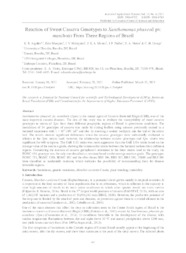Reaction of Sweet Cassava Genotypes to Xanthomonas phaseoli pv. manihotis From Three Regions of Brazil.
Reaction of Sweet Cassava Genotypes to Xanthomonas phaseoli pv. manihotis From Three Regions of Brazil.
Author(s): AQUILES, K. R.; MARQUES, E.; MALAQUIAS, J. V.; MATTOS, J. K. A.; FIALHO, J. de F.; VIEIRA, E. A.; UESUGI, E. H.
Summary: Xanthomonas phaseoli pv. manihotis (Xpm) is the causal agent of Cassava Bacterial Blight (CBB), one of the most important cassava diseases. The aim of this study was to evaluate the susceptibility of sweet cassava genotypes to strains of Xpm from three different geographic regions of Brazil in greenhouse conditions. The inoculation of 14 genotypes of cassava was made by cutting leaflets using scissors previously soaked in a bacterial suspension with 1 × 108 UFC ml-1 and also by inserting a soaked toothpick into the bud of the oldest leaf. The results showed significant differences when the cassava genotypes were individually evaluated in relation to the Xpm strains used; however, the relationship between cassava genotypes and Xpm strains was significant for wilt symptom. The UnB 1111 strain was more aggressive than the UnB 1386 strain based on the average value of the reaction grade, showing the variation that exists between the bacterial isolates from different regions. Considering the reaction of cassava germplasm?s resistance to the three strains used in the study, the BGMC 434 genotype was the only one classified as resistant based on the average reaction grade. The genotypes BGMC 753, BGMC 1289, BGMC 982 and the elite clones BRS 396, BRS 397, BRS 398, 259/08 and BRS 399 were classified as moderately resistant, which indicates the possibility of recommending them for disease favorable regions.
Publication year: 2021
Types of publication: Journal article
Unit: Embrapa Cerrados
Observation
Some of Embrapa's publications are published as ePub files. To read them, use or download one of the following free software options to your computer or mobile device. Android: Google Play Books; IOS: iBooks; Windows and Linux: Calibre.
Access other publications
Access the Agricultural Research Database (BDPA) to consult Embrapa's full library collection and records.
Visit Embrapa Bookstore to purchase books and other publications sold by Embrapa.

